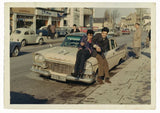Sukhdev Thapar - Remembering the Revolutionary
Sukhdev Thapar (15 May 1907 – 23 March 1931) was an Indian revolutionary. He was a senior member of Hindustan Socialist Republican Association. He was hanged on 23 March 1931 at the age of 23. Sukhdev, born in Nau Ghara Mohalla of Ludhiana, Punjab to Ramlal Thapar and Ralli Devi in a Khatri family. Sukhdev's father died and he was brought up by his uncle Lala Achintram.

Sukhdev was subjected to physical abuse as a child, some of it self-inflicted. Under the influence of socialist communism, he once used Nitric acid to remove a tattoo of the Hindu symbol ‘Om’ on his skin.
He was subjected to caning at school for not saluting a British military officer. He reportedly gave himself the nickname ‘Maarkhaana’, which was the equivalent of the English term ‘punching bag’. Sukhdev had witnessed the brutal atrocities that the Imperial British Raj had inflicted on India, which then led him to join the revolutionaries, vowing to set India free from the shackles of British dominion.
As a young student at Lahore’s National College, he started study circles to delve into India’s past and scrutinize the revolutionary movements happening around the world. It was at this college that he first met Bhagat Singh and Yashpal.

Hindustan Socialist Republican Association
Sukhdev was the chief of Punjab unit of the Hindustan Socialist Republican Association (HSRA), and organised revolutionary cells in Punjab and other areas of North India, vowing to set India free from the shackles of British rule. He also played an active role in several revolutionary activities but he is best remembered for his courageous attack in the Lahore Conspiracy Case.

Lahore Conspiracy Case
In February 1928, the Simon Commission arrived in India to suggest constitutional reforms. The unfair and insulting decision to not have a single Indian member in the Commission led to much anger and disappointment among Indians.

In the resulting protests, veteran leader Lala Lajpat Rai was killed in a brutal cane charge by the police. Seeking revenge for the death of the much-loved freedom fighter, the HSRA planned to assassinate Superintendent of Police James Scott, the British police officer responsible for the cane charge on the senior freedom fighter.
On December 17, 1927, Bhagat Singh and Shivaram Rajguru shot and killed Assistant Superintendent of police John Saunders. They were supported in this act by their compatriots Sukhdev Thapar and Chandrashekhar Azad.
Soon after, Bhagat Singh and fellow revolutionary, Batukeshwar Dutt, threw two bombs and leaflets inside the Central Legislative Assembly (Now Indian Parliament) before offering themselves up for arrest. These were the two charges that were clubbed together by the British Raj in the Lahore conspiracy case that led to the arrest of the young leaders of HSRA.
Court Proceedings and Hunger Strike
Three individuals, Hans Raj Vohra, Jai Gopal and Phanindra Nath Ghosh turned approvers for the Government which led to a total of 21 arrests including those of Sukhdev Thapar, Jatindra Nath Das and Shivaram Rajguru. Sardar Bhagat Singh was re-arrested for the Lahore Conspiracy case, murder of Assistant Superintendent Saunders and bomb manufacturing.
In the last two years of their life in jail, Bhagat Singh, Sukhdev and Rajguru fought one of the most celebrated court battles in the annals of India’s national liberation struggle. Other than using the court as a vehicle for the broadcast of their revolutionary message, they also put the spotlight on the inhuman conditions political prisoners faced in colonial jails.
In jail, Bhagat Singh and his fellow inmates declared an indefinite hunger strike in protest of the prejudiced difference in treatment of the white versus native prisoners and demanded to be recognized as 'political prisoners'.
In the last two years of their life in jail, Bhagat Singh, Sukhdev and Rajguru fought one of the most celebrated court battles in the annals of India’s national liberation struggle. Other than using the court as a vehicle for the broadcast of their revolutionary message, they also put the spotlight on the inhuman conditions political prisoners faced in colonial jails.
In jail, Bhagat Singh and his fellow inmates declared an indefinite hunger strike in protest of the prejudiced difference in treatment of the white versus native prisoners and demanded to be recognized as 'political prisoners'.

The hunger strike received tremendous attention from the press and gathered major public support in favour of their demands. Death of Jatindra Nath Das, after 63 days long fast, led to the negative public opinions intensifying towards the authorities. Bhagat Singh finally broke his 116-day fast, on request of his father and Congress leadership, on October 5, 1929.
The Trial & Sentencing
Trial started against 28 accused in a special session court presided over by Judge Rai Sahib Pandit Sri Kishen, on July 10, 1929. At the time of their execution, Bhagat Singh and Sukhdev Thapar were just 23 years old while Shivaram Rajguru was only 22.

The rafters were removed from under their feet. The dead bodies of the three remained hanging on the scaffold. They were brought down and examined by the doctor and declared dead. At dusk their bodies were loaded on the truck for cremation and cremated near Ganda Singh Wala village in Ferozepur on the edge of Sutlej. When the villagers reached on the spot, the half-burnt bodies were thrown in the Sutlej River by the British soldiers.

Several thousand people gathered at various places to pay homage to India’s beloved sons after they were hanged on March 23, 1931 and cremated on the banks of the Sutlej River at Hussainwala, Punjab

Though we cannot repay the freedom fighters, we can make an effort to to learn and educate our children about them.
Blog Credits: My Malice and Bias & City History



